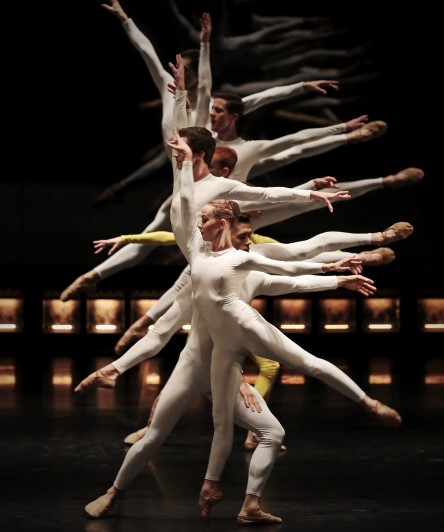Review: FIFTEEN DANCERS AND CHANGEABLE TEMPO at Grand Théâtre

On September 15th, the Grand Théâtre of Luxembourg had the pleasure of presenting a performance by the National Ballet Company of Portugal. This was a one-night-only event, directed by João Penalva and choreographed by Rui Lopes Graça. Both artists are well known for the versatility of their work, one of the reasons why they conducted this show in collaboration with MUDAM, the most prominent museum of modern art of the Grand Duchy. "Fifteen Dancers and Changeable Tempo" was completely sold out, and it was widely refreshing to see such a mixed group of people attending such a refined dance performance. In this memorable night, men and women of all ages and nationalities got together to see a remarkable and graceful combination of movement, sound and light. 
Let us start with sound, since that was one of the most interesting aspects of this evening's event. Unlike most productions presented in Luxembourg, which often have a band playing live during the show, the soundtrack was previously conceived by musician David Cunningham, who worked on a collection of noises produced by both nature and society. Having decided not to read anything about "Fifteen Dancers and Changeable Tempo" until after the end, I was caught off guard and surprised by this choice. Not because of the interesting contrast between a graceful choreography and the raw sounds of Earth and Man, but rather because at first this connection felt a bit random. Having far more experience in theatre, musical theatre and even opera, it took me a couple of scenes to understand that this performance did not have an objective narrative, nor an explicit message, but was rather composed by a series of subjective and loosely connected sequences.
The strength, passion and grace of the movements was altered almost every time there was a change of sounds, with the reaction of the dancers to the different types of sound being carefully adjusted to the spirit of the scene. For instance, only men danced to the harsh noises of a factory, in a sequence that opened with a single choreography for all dancers on stage, who then broke off into two or three groups with inter-crossed steps. This managed to capture the mechanized mindset of a factory, and contrasted greatly with the more delicate and familiar movements displayed to the sound of mild rain, birds and crickets. When nature was the theme, the ensemble would often dance in close proximity, with hands touching shoulders, in the fraternal spirit of a pack. The order of the soundtrack also provided material for reflection. Again, like most of the elements in this show, everything is open for individual interpretation, yet it felt thought-provoking to, for instance, produce sounds of nature right after a sequence of church bells. 
The lights on and off stage were adjusted in colour and strength throughout the night, yet they did not seem to stand out as much as the choreography and the music choices. Since there was no obvious narrative progression, there were also no characters standing out, making it impossible for us to individually assess the performance of the dancers. The ensemble was, however, flawless in its delivery and no doubt deserved the continuous applause it received at the end. We look forward to seeing more of their work in Luxembourg.
Image credit: Bruno Simão
Reader Reviews

Videos

